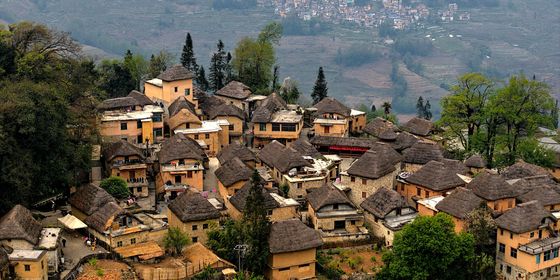The sad tale of General Ming Rui, who fought and died in a forgotten war between China and Myanmar
The spring rains of 1768 have come to Burma. Pouring sheets of water mean thick mud at every turn, movement is impossible, but it doesn’t matter: The Manchu General Ming Rui has nowhere left to go. A retreat means crossing 400 km of treacherous terrain—including several high mountain passes—before reaching the relative safety of Yunnan. That is, if retreat were even possible. The armies of the Burmese Konbaung Dynasty have Ming Rui, and his few remaining soldiers, surrounded.
In November, Ming Rui had led an army of over 30,000 elite banner troops over the frontier and into Burma. He had pushed his men southward and divided his forces in a pincer attack that then stalled 50 kilometers northeast of the Burmese capital at Ava.
Now it is March, and only 2,500 of his men remain alive.
Several divisions had fallen to guerrilla attacks organized by the intrepid Burmese generals Maha Thiha Thur and Maha Sithu. Outgunned, outmanned, outnumbered, and out planned, the Burmese employed the same repertoire of asymmetrical resistance George Washington and Alexander Hamilton would use to against the British a decade later in the American Revolution.
But most of Ming Rui’s men had died fighting an enemy they couldn’t see.
Two previous invasions, in 1765 and 1766, foundered when the Chinese troops of the Green Standard Army succumbed to a riot of tropical infections. Malaria, dysentery, and cholera laid waste to whole units.
For this campaign, the third attempt by the Qing to bring Burma to heel, Ming Rui thought he had taken all necessary precautions. Instead of Chinese troops he rallied the Manchus, men of the banners, some from posts far in the north and west of the empire. These were battle hardened men accustomed to fighting elusive foes.
The Green Standard Army were the dregs; Ming Rui would mobilize the elite.
He had also launched his expedition to coincide with the cooler and drier winter months when, as everybody knew, the miasmas that caused disease were sure to be less.
But the Manchu Banner troops fared little better than their Chinese counterparts. Better prepared for battle in the cold wastes of the steppe or the desert basins of Xinjiang, the Banner men wilted in the heat and stink of the Burmese river valleys. As winter gave way to spring, temperatures soared, the rains came, and clouds of mosquitos swarmed day and night. Waters rose around them, and once dry cramps became muddy cesspools. The Burmese armies had cut the Qing supply lines back to Yunnan, and the troops were running short of food. Men died standing guard duty, and all the Burmese soldiers had to do was to watch.
At the time, nobody on the Qing side—not even Ming Rui—knew just why they were there. But looking back, the Sino-Burmese Wars were another example—all too common in the 18th and 19th centuries—of a local conflict over trade escalating into bloody retribution in the preservation of national honor.
The frontier between the Qing Empire and Burma had been contentious for over a century, ever since the last claimant to the Ming throne had escaped across the mountains and taken refuge with the Burmese king in 1661. When thousands of Ming loyalists followed, and began establishing their own camps and communities, what had at first looked like a charitable case of humanitarian asylum began to resemble a slow-motion annexation of the northern frontier.* Finally, the Qing court sent Wu Sangui, the general who had initially invited the Manchus into China, to apprehend the Ming prince. Given the situation, the Burmese were happy to hand him over, an act which probably saved Burma from becoming the southernmost province of the newly ascendant Qing Empire.
In the 100 years since a rugged frontier kept the two sides apart. The mountainous region between Yunnan and Northern Burma was a wild place. Local rulers operated with limited interference from either faraway Beijing or the Burmese court at Ava. Neither the Qing or the Burmese were sure how to deal with these “hill tribes,” preferring instead to enfeoff local leaders and let them administer these areas. These local leaders became adept at playing sides, sometimes sending tribute one way, sometimes another, and even at times professing loyalty in both directions.
But by the 18th century, Qing imperial aspirations demanded a new kind of order in the borderlands. Millions of Chinese pioneers had settled in the wilds of Yunnan Province, lured into the frontier highlands by rich silver strikes and the prospects of making money in minerals and trade far from the prying eyes of the central government. It was like the HBO show Deadwood, but with Chinese characteristics.
At the same time, a new dynasty in Burma, the Konbaung, founded by the energetic King Alaungpaya, began expanding its territorial reach. Burmese armies from the Upper Irrawaddy reclaimed the southern Irrawaddy Delta region from the Mon People and then pushed into the territories of Siam, conquering much of what is today Northern and Western Thailand.
The people of the Sino-Burmese frontier began feeling the pressure from both sides and had limited room to maneuver. Fights among clans and different ethnic groups over resources and mining rights became proxy wars for Beijing and Ava. In 1765, a local trade dispute had escalated when the governor of Yunnan decided to send troops across the frontier.
The irony of a Qing official using trade as a pretext for imperial expansion would become more apparent 80 years and an Opium War later.
But in 1768, Ming Rui was stuck in the muck. It was an ignoble place to die. He was a veteran of the campaigns in Ili, out in the vast deserts of what is today Xinjiang, fighting to expand Qing imperial influence into Central Asia. He was the son-in-law of the Qianlong Emperor, who, even as Ming Rui contemplated his very bleak future, was busy in the Forbidden City already planning how to administer his newest territorial possession.
In his hubris, the emperor never doubted that the Manchu banners would dominate against what Qianlong felt were barbarians and betel-nut chewers.
If the Emperor had been familiar with the American version of football, he might have compared the 1767-1768 campaign to the New England Patriots playing a small town high school varsity team. Ming Rui was his Tom Brady. The question was not if he would win, but what to do with the trophy.
When news from the front finally arrived in Beijing, it was in the grotesque form of a lock of hair: a cut queue. Facing insurmountable odds, Ming Rui had made one last stand at the town of Maymo (today known as Pyinoolwin). Gravely wounded in the fight, Ming Rui took his sword and cut his queue, a sign of loyalty and duty to the Emperor, and hanged himself from a nearby tree. He would not flee through the jungles back to Yunnan.
There would be one more attempt against the Burmese. In 1769, Ming Rui’s uncle, the Manchu Grand Councilor Fuheng, would lead 60,000 troops as well as a fleet of war boats manned by experienced sailors from Fujian only to meet the main force of the Burmese army, called back from the front in Siam. Once again, disease, guerrilla tactics, and long supply lines conspired against the Qing troops. Fuheng lost a third of his force and then sued for terms.
The Burmese were ready for peace. They had held out against one of the largest and most powerful empires in the world, but they could not do so indefinitely. They had successfully defended their country, but at the cost of the Konbaung Dynasty’s own territorial ambitions in Siam.
Despite the truce, it would take some time for wounds to heal and it wouldn’t be until 1790 that relations normalized between two sides. For the Qing, the resumption of trade missions from Burma to China meant that the Burmese court had accepted the superiority of the Son of Heaven by sending tribute. The Burmese knew better, but they kept a careful eye on their northern borders.
Today, the Sino-Burmese Wars are better known in Myanmar than they are in China or the rest of the world. In China, Thailand, and Vietnam, past incursions by Chinese armies remain fresh in people’s minds as lessons from the past and possible inspiration for the future.
*Almost two centuries later, the Burmese would once again face an incursion by a defeated Chinese army looking for refuge. In the 1950s and 1960s, thousands of former KMT soldiers and their families fled the armies of the CCP and settled along the Sino-Burmese border. Once in Burma, they resumed contacts with the KMT on Taiwan. With military assistance from Chiang Kai-shek’s government, the proceeds from a flourishing business in opium, and the largesse of the CIA, they began a series of ineffectual but provocative military adventures against PLA forces in Yunnan province before being unceremoniously booted across the border into Thailand.
References
Dai Yingcong, “A Disguised Defeat: The Myanmar Campaign of the Qing Dynasty,” Modern Asian Studies, Volume 38, Number 1 (Feb., 2004), pp. 145-189
Giersch, C. Pat, “Social Change in Southwest China’s Early Modern Frontier, 1700-1880,” The Journal of Asian Studies, Volume 60, Number 1 (Feb., 2001), pp. 67-94
Jung, L.K., “The Sino-Burmese War, 1766-1770: War and Peace under the Tributary,’ China Papers 24 (1971), pp. 74-103
Thant Myint-U, The River of Lost Footsteps: A Personal History of Burma. (Farrar, Strauss, and Giroux, 2008)
Cover image from Ctrip












